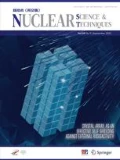Abstract
Thermal aging effects on surface of 2.5 MeV Fe ion-irradiated Fe–0.6%Cu alloy were investigated using positron annihilation techniques. The samples were irradiated at 573 K to a dose of 0.1 dpa. Their thermal aging was performed at 573 K for 5, 50 and 100 h. From the results of Doppler broadening measurement, an obvious trough could be seen in near-surface region from the S parameters and inflection point form at S–W curves. This indicates changes in the annihilation mechanism of positrons in surface region after thermal aging. Coincident Doppler broadening indicates that the density of Cu precipitates in the thermal aged samples decreased, due to recovery of the vacancies.



Similar content being viewed by others
References
F. Soisson, C. Fu, Cu-precipitation kinetics in α-Fe from atomistic simulations: vacancy-trapping effects and Cu-cluster mobility. Phys. Rev. B 76, 214102 (2007). doi:10.1103/PhysRevB.76.214102
S.I. Golubov, Y.N. Osesky, A. Serra et al., The evolution of copper precipitates in binary Fe–Cu alloys during ageing and irradiation. J. Nucl. Mater. 226, 252–255 (1995). doi:10.1016/0022-3115(95)00088-7
G.J. Ackland, D.J. Bacon, A.F. Calder et al., Computer simulation of point defect properties in dilute Fe–Cu alloy using a many-body interatomic potential. Philos. Mag. A 75, 713–732 (1997). doi:10.1080/01418619708207198
M. Lambrecht, A. Almazouzi, Positron annihilation study of neutron irradiated model alloys and of a reactor pressure vessel steel. J. Nucl. Mater. 385, 334–338 (2009). doi:10.1016/j.jnucmat.2008.12.020
Y. Nagai, Z. Tang, M. Hassegawa et al., Irradiation-induced Cu aggregations in Fe: an origin of embrittlement of reactor pressure vessel steels. Phys. Rev. B 63, 134110 (2001). doi:10.1103/PhysRevB.63.134110
J.Z. Liu, A. Walle, G.F. Ghosh et al., Structure, energetics, and mechanical stability of Fe–Cu bcc alloys from first-principles calculations. Phys. Rev. B 72, 144109 (2005). doi:10.1103/PhysRevB.72.144109
D. Molnar, P. Binkele, S. Hocker et al., Atomistic multiscale simulations on the anisotropic tensile behavior of copper-alloyed alpha-iron at different states of thermal ageing. Philos. Mag. 92, 586–607 (2012). doi:10.1080/14786435.2011.630690
B. Minov, M. Lambrecht, D. Terentyev et al., Structure of nanoscale copper precipitates in neutron-irradiated Fe–Cu–C alloys. Phys. Rev. B 85, 024202 (2012). doi:10.1103/PhysRevB.85.024202
G.R. Odette, On the dominant mechanism of irradiation embrittlement of reactor pressure vessel steels. Scr. Metall. 17, 1183 (1983). doi:10.1016/0036-9748(83)90280-6
T. Ishizaki, T. Yoshiie, K. Sato et al., Precipitation of Cu in Fe–Cu alloys by high-speed deformation. Mater. Sci. Eng. A 350, 102–107 (2003). doi:10.1016/S0921-5093(02)00706-2
Y. Nagai, K. Takadate, Z. Tang et al., Positron annihilation study of vacancy-solute complex evolution in Fe-based alloys. Phys. Rev. B 67, 224202 (2003). doi:10.1103/PhysRevB.67.224202
R.G. Carter, N. Sonedab, K. Dohib et al., Microstructural characterization of irradiation-induced Cu-enriched clusters in reactor pressure vessel steels. J. Nucl. Mater. 298, 211–224 (2001). doi:10.1016/S0022-3115(01)00659-6
Z. Chen, N. Kioussis, N. Ghoniem, Influence of nanoscale Cu precipitates in α-Fe on dislocation core structure and strengthening. Phys. Rev. B 80, 184104 (2009). doi:10.1103/PhysRevB.80.184104
K. Morita, S. Ishino, T. Tobita et al., Use of high energy ions for the mechanistic study of irradiation embrittlement in pressure vessel steels using Fe–Cu model alloys. J. Nucl. Mater. 304, 153–160 (2002). doi:10.1016/S0022-3115(02)00877-2
X.Z. Cao, P. Zhang, Q. Xu et al., Cu precipitates in Fe ion irradiated Fe–Cu alloys studied using positron techniques. J. Phys. C 443, 012017 (2013). doi:10.1088/1742-6596/443/1/012017
H.B. Wu, X.Z. Cao, G.D. Cheng, et al., Effects of copper precipitates on microdefects in deformed Fe–1.5 wt%Cu alloy. Phys. Status. Solidi. A 210, 1758–1761 (2013). doi:10.1002/pssa.201228849
J.A. Baker, P.G. Coleman, Measurement of coefficients for the back-scattering of 0.5–30 keV positrons from metallic surfaces. J. Phys. C 21, L875–L880 (1988). doi:10.1088/0022-3719/21/23/003
A.P. Knights, P.G. Coleman, The observation of structure in the dependence of the 1 keV positron backscattering coefficient on target atomic number. J. Phys.: C Matter. 7, 3485–3492 (1995). doi:10.1088/0953-8984/7/18/012
Y. Nagai, M. Hasegawa, Z. Tang, et al., Positron confinement in ultrafine embedded particles: quantum-dot-like state in an Fe–Cu alloy. Phys. Rev. B 61, 6574 (1999). doi:10.1103/PhysRevB.61.6574
Q.L. Wang, J.Z. Zhao, A model describing the microstructure evolution in Fe–Cu alloys during thermal aging. Mater. Sci. Eng. A 528, 268–272 (2010). doi:10.1016/j.msea.2010.09.012
Author information
Authors and Affiliations
Corresponding author
Additional information
This work was supported by the National Natural Science Foundation of China (Nos. 91026006, 91226103, 11475193, 11475197, 11575205 and 11505192) and Beijing Natural Science Foundation (No. 1164017).
Rights and permissions
About this article
Cite this article
Hu, YC., Cao, XZ., Zhang, P. et al. Effects of thermal aging on Fe ion-irradiated Fe–0.6%Cu alloy investigated by positron annihilation. NUCL SCI TECH 28, 16 (2017). https://doi.org/10.1007/s41365-016-0172-9
Received:
Revised:
Accepted:
Published:
DOI: https://doi.org/10.1007/s41365-016-0172-9




